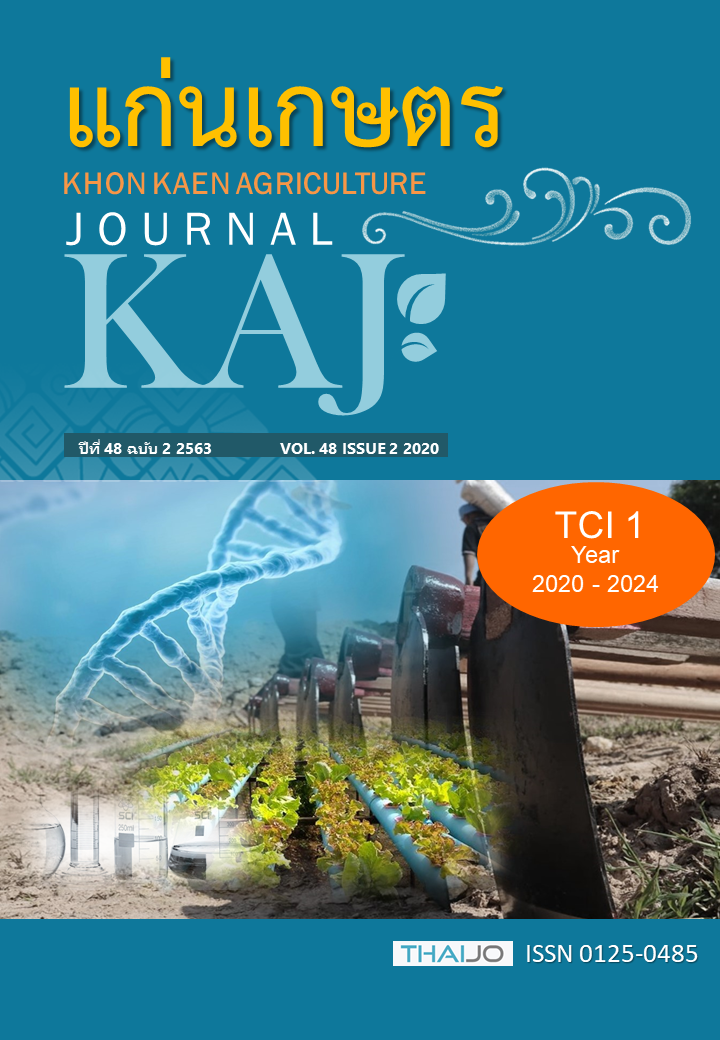การคัดเลือกเชื้อแบคทีเรียปฏิปักษ์ที่ควบคุมเชื้อสาเหตุโรคแอนแทรคโนสพริกในแนวกว้างและช่วยส่งเสริมการเจริญเติบโตของพืช
Main Article Content
บทคัดย่อ
งานวิจัยนี้มีวัตถุประสงค์ในการคัดเลือกเชื้อแบคทีเรียปฏิปักษ์ควบคุมเชื้อสาเหตุโรคแอนแทรคโนสพริกในแนวกว้าง และช่วยส่งเสริมการเจริญเติบโตของพืชด้วย ดำเนินการวิจัยโดยนำเชื้อแบคทีเรีย 11 ไอโซเลต ได้แก่ Bacillus spp. Bacillus-Ba029, Bacillus-Ba033, Bacillus-Ba037N, Bacillus-NTS3, Bacillus-MS4, Bacillus-S32, Bacillus-PSK, Bacillus-BS, Bacillus-BK, Streptomyces-PR15 และStreptomyces-PR87 มาทดสอบความสามารถยับยั้งการเจริญของเส้นใยเชื้อรา Colletotrichum gloeosporioides, C.capsici และ C. acutatum โดยวิธี dual culture bioassay พบว่าเชื้อแบคทีเรียปฏิปักษ์ 9 ไอโซเลต ได้แก่ Streptomyces-PR15, Streptomyces-PR87, Bacillus-Ba029, Bacillus-Ba033, Bacillus-NTS3, Bacillus-MS4, Bacillus-S32, Bacillus-BS และ Bacillus-BK สามารถยับยั้งเส้นใยของเชื้อรา Colletotrichum spp.ทั้ง 3 สปีชีส์ได้อย่างชัดเจน เส้นใยของเชื้อราบริเวณที่เกิดแนวยับยั้งมีลักษณะบวมพอง เส้นใยเสียสภาพแตกหัก ส่วน Bacillus-Ba037N และ Bacillus-PSK ยับยั้งการเจริญของเชื้อ Colletotrichum spp. บางไอโซเลตได้เพียงเล็กน้อย เชื้อแบคทีเรียปฏิปักษ์ทั้ง 11 ไอโซเลตสามารถสังเคราะห์ Indole-3-acetic acid (IAA) ได้มีค่าตั้งแต่ 6.23-19.42 µg/ml โดยไอโซเลต Bacillus-PSK มีค่า IAA สูงที่สุด เท่ากับ 19.42 µg/mlและมี 9 ไอโซเลตที่มีความสามารถในการละลายฟอสเฟตได้ ได้แก่ Streptomyces-PR15, Streptomyces-PR87, Bacillus-Ba029, Bacillus-Ba033, Bacillus-NTS3, Bacillus-MS4, Bacillus-S32, Bacillus-BS และ Bacillus-BK โดยเชื้อ Streptomyces-PR87 มีประสิทธิภาพในการละลายฟอสเฟตที่ผสมอยู่ในอาหารทดสอบได้มากที่สุดมีค่า solubilization index (S.I) เท่ากับ 3.5 รองลงมาคือ Bacillus-NTS3 เท่ากับ 3.368 จากผลการวิจัยได้คัดเลือกเชื้อแบคทีเรียปฏิปักษ์ที่ควบคุมเชื้อรา Colletotrichum spp. ได้หลายสปีชีส์และมีกลไกการส่งเสริมการเจริญเติบโตของพืชได้ดีมากไว้ 4 ไอโซเลต ได้แก่ Streptomyces-PR15, Bacillus-Ba033, Bacillus-Ba029 และ Bacillus-NTS3 สำหรับประเมินประสิทธิภาพการควบคุมโรคแอนแทรกโนสที่ติดมากับเมล็ดพันธุ์พริกและส่งเสริมการเจริญเติบโตของต้นกล้าพริกและการควบคุมโรคแอนแทรกโนสในแปลงปลูกต่อไป
Article Details
เอกสารอ้างอิง
เพชรรัตน์ ธรรมเบญจพล, 2562. โครงการประสิทธิภาพของแบคทีเรียปฏิปักษ์และวิธีการใช้เพื่อควบคุมโรคเมล็ดพันธุ์และช่วยส่งเสริมการเจริญเติบโตของต้นกล้าพริก. รายงานวิจัยฉบับสมบูรณ์. สำนักงานกองทุนสนับสนุนการวิจัย (สกว.)
รัติกาล ยุทธศิลป์ และ เพชรรัตน์ ธรรมเบญจพล. 2555. การประเมินประสิทธิภาพของเชื้อ Streptomyces spp. ปฏิปักษ์ในการควบคุมเชื้อรา Colletotrichumcapsici สาเหตุโรคแอนแทรกโนสของพริก. แก่นเกษตร 40: 224-232.
รัติกาล ยุทธศิลป์ เพชรรัตน์ ธรรมเบญจพล และ อนันต์ หิรัญสาลี. 2554. การคัดเลือกไอโซเลต Streptomyces ที่มีศักยภาพสูงในการควบคุมไส้เดือนฝอยรากปม (Meloidogyne incognita).แก่นเกษตร 39: 219-224.
รัติกาล ยุทธศิลป์. 2558. การควบคุมโรคแอนแทรคโนสและรากปมของพริกโดย Streptomyces spp. ปฏิปักษ์. วิทยานิพนธ์ปริญญาวิทยาศาสตร์มหาบัณฑิต. มหาวิทยาลัยขอนแก่น.
ภัทรกร ภูริชินวุฒิ เพชรรัตน์ ธรรมเบญจพล พิศาล ศิริธร วีระศักดิ์ ศักดิ์ศิริรัตน์ และอัศนี ปาจีนบูรวรรณ์. 2547. Streptomyces :ความสามารถในการยับยั้งเชื้อรา Didymellabryoniae และการสังเคราะห์ hydrolytic enzymes. หน้า 454-465 ในการสัมมนาวิชาการเกษตรแห่งชาติ ประจำปี 2547 วันที่ 26-27 มกราคม 2547 ณ ห้องประชุมกวีจุติกุล คณะเกษตรศาสตร์ มหาวิทยาลัยขอนแก่น.
ภัทรกร ภูริชินวุฒิ. 2548. พันธุศาสตร์โมเลกุลของเชื้อ Streptomyces spp. ที่ยับยั้งการเจริญของเชื้อแบคทีเรีย Acidovorax avenae subsp. citrulli และเชื้อรา Didymella bryoniae. วิทยานิพนธ์ปริญญา วิทยาศาสตร์มหาบัณฑิต. มหาวิทยาลัยขอนแก่น.
วีรกรณ์ แสงไสย์. 2556. บทบาทของ Streptomyces ปฏิปักษ์ในการส่งเสริมการเจริญเติบโตและกระตุ้นภูมิต้านทานโรคไวรัส TMV ของพริก. วิทยานิพนธ์ปริญญาวิทยาศาสตรมหาบัณฑิต มหาวิทยาลัยขอนแก่น
สำนักงานเศรษฐกิจการเกษตร. 2561. สถิติการค้าสินค้าเกษตรไทยกับต่างประเทศปี 2561. ศูนย์สารสนเทศการเกษตร สำนักงานเศรษฐกิจการเกษตร กระทรวงเกษตรและสหกรณ์.
อัศศิริ กลางสวัสดิ์ และ เพชรรัตน์ ธรรมเบญจพล. 2556. วิธีการใช้ Streptomyces-PR87 ในการส่งเสริมการเจริญเติบโตของมะเขือเทศ. แก่นเกษตร 41: 205-212.
Amaresan, N.,V. Jayakumar., K. Kumar and N. Thajuddin. 2012. Isolation and characterization of plant growth promoting endophytic bacteria and their effect on tomato (Lycopersicon esculentum) and chilli (Capsicum annuum) seedling growth. Ann Microbiol 62:805–810.
Ashwini, N. and S. Srividya. 2013. Potentiality of Bacillus subtilis as biocontrol agent for management of anthracnose disease of chilli caused by Colletotrichum gloeosporioides OGC1. Biotech 4:127-136.
Barea, J.M., M.J.Pozo., A.Rosario and A.A. Concepcio. 2005. Microbial co-operation in the rhizosphere. Experimental Botany; 56:1761–1778.
Buensanteai, N., M. Sompong., K. Thamnu., D. Athinuwat., A. Brauman and C. Plassard. 2013. The plant growth promoting bacterium Bacillus sp. CaSUT007 produces phytohormone and extracellular proteins for enhanced growth of cassava. African Journal of Microbiology Research 7: 4949-4954.
Choudhary, D.K. and B.N. Johri. 2009. Interactions of Bacillus spp. and plants with special reference to induced systemic resistance (ISR). Microbiol 164: 493-513.
Kabir, L., W. K. Sang., S.K. Yun and S.L. Youn. 2012. Application of Rhizobacteria for Plant Growth Promotion Effect and Biocontrol of Anthracnose Caused by Colltotrichumacutatum on Pepper. Mycobiology 40: 244-251.
Kang, S.M., R. Radhakrishnan., Y.H. You., G.J. Joo., I.J. Lee., K.E. Lee and J.H. Kim. 2014. Phosphate Solubilizing Bacillus megaterium mj1212 Regulates Endogenous Plant Carbohydrates and Amino Acids Contentsto Promote Mustard Plant Growth. Indian Journal Microbiol 54:427–433.
Khamna, S., A .Yokota., J.F. Peberdy and S. Lumyong. 2010. Indole-3-acetic acid production by Streptomyces sp. isolated from some Thai medicinal plant rhizosphere soils. Biological Sciences 4: 23-32.
Illmer, P. and Schinner, F. 1995. Solubilization of inorganic calcium phosphates-solubilization mechanisms. Soil Biol. Biochem. 27: 257-263.
Pikovskaya, R.I . 1948. Mobilization of phosphorus in soil connection with the vital activity of some microbial species. Microbiologiya;17 :362–370.
Rattikan, Y., P. Thummabenjapone and A. Hiransalee. 2015. Antagonistic Streptomyces selection to broad spectrum for biological control of Colletotrichum spp., causal agent of anthracnose in Chilli. Journal of Pure and Applied Microbiology 9:2705.
Shoda, M. 2000. Bacterial control of plant diseases. J. Bioscience and Bioengineering 89: 515-521.
Suwannarat, S., S.Steinkellner., P. Songkumarn and S. Sangchote.2017. Diversity of Colletotrichum spp. isolated from chili pepper fruit exhibiting symptoms of anthracnose in Thailand. Mycological Progress 16: 677–686
Sharma, S.B., Sayyed, R.Z., Trivedi, M.H., and Gobi, T.A. 2013. Phosphate solubilizing microbes: sustainable approach for managing phosphorus deficieencyin agriculture soil.Springerplus 2: 587-600.


